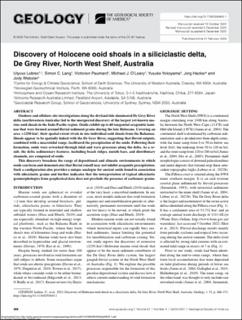Discovery of Holocene ooid shoals in a siliciclastic delta, De Grey River, North West Shelf, Australia
Lebrec, Ulysse; Lang, Simon C.; Paumard, Victorien; O'leary, Michael J.; Yokoyama, Yusuke; Hacker, Jorg; Webster, Jody
Peer reviewed, Journal article
Published version
Permanent lenke
https://hdl.handle.net/11250/3116473Utgivelsesdato
2023Metadata
Vis full innførselSamlinger
- NGI articles [1037]
Sammendrag
Onshore and offshore site investigations along the dryland tide-dominated De Grey River delta (northwestern Australia) led to the unexpected discovery of the largest yet-known marine ooid shoals in the Indo-Pacific region. Ooids exhibit up to 60 tangential aragonitic laminae that were formed around fluvial sediment grains during the late Holocene. Covering an area >1250 km2, their spatial extent rivals in size individual ooid shoals from the Bahamas. Shoals appear to be spatially linked with the De Grey River, suggesting that fluvial outputs, combined with a macrotidal range, facilitated the precipitation of the ooids. Following their formation, ooids were reworked through tidal and wave processes along the delta. As a result, the delta sedimentary features, including beach ridges, mouth bars, and distributary channels, are composed of ooids. This discovery broadens the range of depositional and climatic environments in which ooids can form and demonstrates that fluvial runoff may not inhibit aragonite precipitation. Such a configuration also provides a unique analogue for ancient ooids found in association with siliciclastic grains and further indicates that the interpretation of typical siliciclastic geomorphologies from geophysical data does not preclude the presence of carbonate grains. Discovery of Holocene ooid shoals in a siliciclastic delta, De Grey River, North West Shelf, Australia
